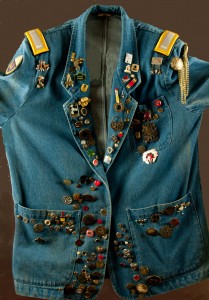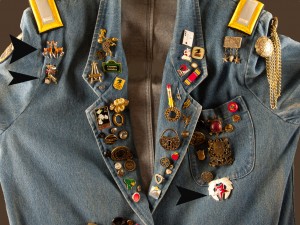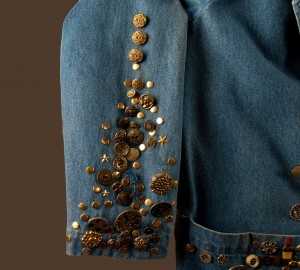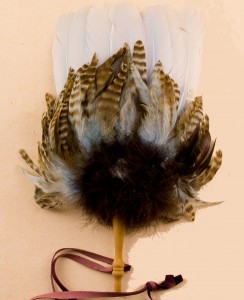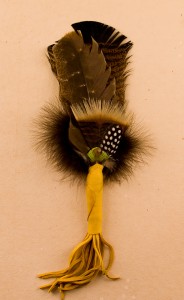In the early 80s, having started an art quilt business, I was looking for other ways to supplement my income. My big hope was that I would be able to quit teaching science in public school and work on my art work full time. My mother-in-law did extensive needlepoint, and spent quite a bit of money on the canvases that she bought and the materials that she used, so I was inspired to see about selling some that I created. There was a needlepoint store here in my town that was willing to take canvases on commission, so I began my very short career in creating needlepoint canvases.
I purchased an assortment of professional markers whose brand name I don’t remember now. At the time, they were the best on the market, and had the most intense colors. The problem was that they bled some onto the needlepoint canvas, so I couldn’t get the crisp outlines of color that were on commercially printed ones. You can see in the above photos how fuzzy the lines are.
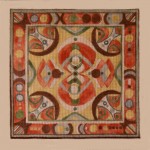
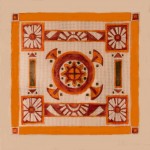 Here are two more needlepoint canvases that I created during that time period. If you’ve read any of my posts about my early geometric art quilts, you can see how they influenced the style of these needlepoint canvases. While my mother-in-law made many “art” looking needlepoint pieces, the town where I lived seemed to be only buying flower and cute animal motifs. I think that I sold a few before the store went out of business, but I never recovered all of the money that I spent on the markers and other supplies to make the canvases. Fortunately, the materials could be used for other projects, so the money wasn’t wasted.
Here are two more needlepoint canvases that I created during that time period. If you’ve read any of my posts about my early geometric art quilts, you can see how they influenced the style of these needlepoint canvases. While my mother-in-law made many “art” looking needlepoint pieces, the town where I lived seemed to be only buying flower and cute animal motifs. I think that I sold a few before the store went out of business, but I never recovered all of the money that I spent on the markers and other supplies to make the canvases. Fortunately, the materials could be used for other projects, so the money wasn’t wasted.
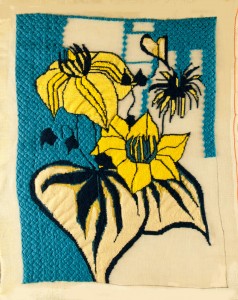 I even tried doing some needlepoint, as the pieces were much more portable when traveling than my art quilts. A book that came out in 1974 that heavily influenced me was Needlepoint: The art of canvas embroidery, by Mary Rhodes. It was the first time that I had seen other stitches besides the usual tent stitch or petit point, and the artistic possibilities of the medium appealed to me. The problem was that to do the work well (and evenly), it needed to be worked on a frame to keep the piece from warping. To the left is my one serious attempt at doing a needlepoint piece that I had designed. The clematis flowers were fun to draw, but because the frame wouldn’t fit into a suitcase, working the canvas on my lap caused the work to quickly become hopelessly warped. This is the stage that the piece is still in, over thirty years later. I spent too much time on it to throw it out… yet, so it’s gone into my “Personal Archeology” box and might be re-purposed at some future time.
I even tried doing some needlepoint, as the pieces were much more portable when traveling than my art quilts. A book that came out in 1974 that heavily influenced me was Needlepoint: The art of canvas embroidery, by Mary Rhodes. It was the first time that I had seen other stitches besides the usual tent stitch or petit point, and the artistic possibilities of the medium appealed to me. The problem was that to do the work well (and evenly), it needed to be worked on a frame to keep the piece from warping. To the left is my one serious attempt at doing a needlepoint piece that I had designed. The clematis flowers were fun to draw, but because the frame wouldn’t fit into a suitcase, working the canvas on my lap caused the work to quickly become hopelessly warped. This is the stage that the piece is still in, over thirty years later. I spent too much time on it to throw it out… yet, so it’s gone into my “Personal Archeology” box and might be re-purposed at some future time.
So, that was my year long venture into being a needlepoint artist. I’ve since learned to ask a lot more questions before spending too much money on exploring a new medium. While I love to experiment, I’ve narrowed down my artistic pursuits, at least for the past twenty five years to art quilts. Those materials take up a whole room as it is and are spreading out into other parts of the house. I can’t imagine getting to serious about other media.
What artistic media have you explored? What is some of the advice that you would give to others, so that we don’t have to re-invent the wheel?
Why not leave a comment as to your thoughts on this posting. Please take a minute, fill out the form below or by clicking on the “comments/no comments link” at the top of the posting, and then share your ideas with the rest of us. We all grow when we share our thoughts and impressions, so why not join our growing community of those who appreciate art quilts and textile arts. We’d love to hear from you!… and PLEASE tell like minded souls about this blog! The more readers and contributors, the more I write because encouragement helps the words flow!
You can see more of my art work on my web site at www.fiberfantasies.com (be patient as it loads; it’s worth it), my healing work at www.transitionportals.com and can find me on Google + , Facebook (for Transition Portals) Facebook (for Fiber Fantasies), and Twitter.
To find out how to buy my art work, please check out “How to Buy my Art Work” in the “Pages” section to the right of this blog.


